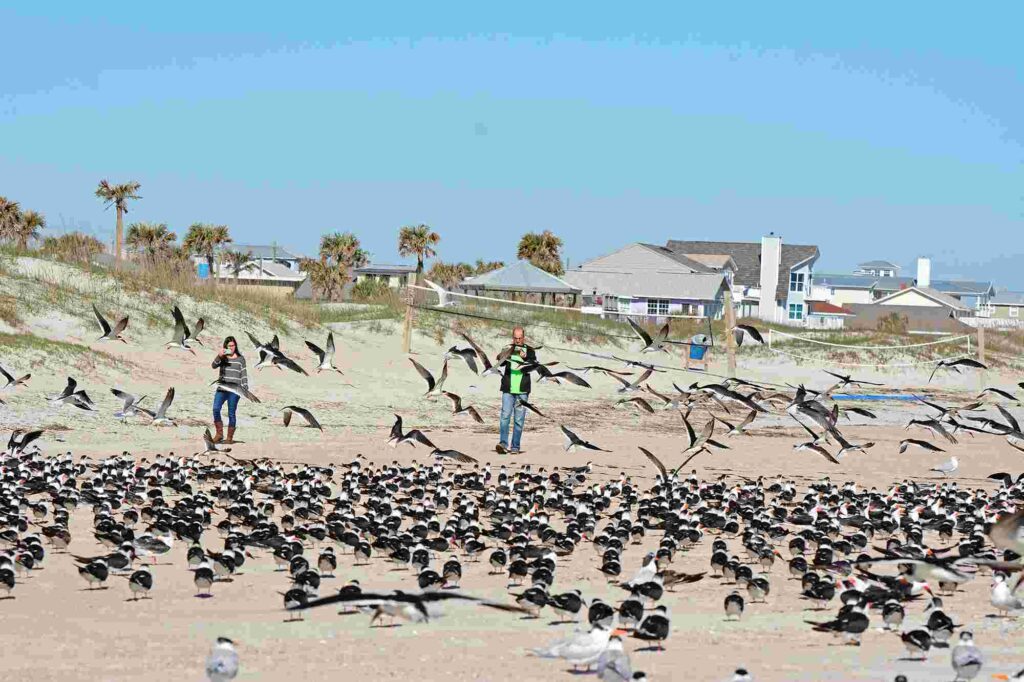By Pat Leary
January 7, 2021

The term “snow bird” has become cliché for Florida’s, winter-season, residents from more northern states, but long before Henry Flagler’s railroad, retirement communities and tourist development boards, this state hosted legions of nature’s “snow birds”. That is, migrant and wintering birds escaping winter’s harsher weather. Species ranging from hummingbirds to eagles move into Florida during the colder months of the year.
Among this group are, strikingly- contrasting, Black Skimmers (Rynchops niger). A cosmopolitan species related to terns, skimmers in North America breed along gulf and Atlantic shores from Florida to Massachusetts, but winter sees the arrival of more northern populations. Because researches are now marking birds with uniquely colored and coded bands, we are learning more about their annual movements.

Resightings of marked skimmers from Cumberland Island to the St. John’s river have included birds from North Carolina (black bands), Virginia (white bands), New Jersey (blue bands), New York (Yellow bands) and the northernmost population on Martha’s Vineyard, MA (orange bands) Serendipitously, birds from Nassau County, NY, winter in Nassau County, FL!
In both breeding and wintering seasons, skimmers are highly gregarious and form conspicuous flocks along or near beaches. Numbers can range from fifty birds to over a thousand. Paradoxically, winter flocks will often gravitate to very busy public beaches where they are subjected to frequent disturbance and occasional harassment. Inconsiderate folks walk or even run into such resting flocks to collect a “Kodak moment” with their phone cameras. What such opportunists don’t comprehend is that the skimmers are nocturnal feeders and retire to the beach to rest and sleep in the bright sunshine and a cursory survey of such flocks will find many with their heads “tucked under” and eyes closed. Though undocumented, skimmers may sacrifice undisturbed rest for reduced threats from natural predators on busy beaches, but it substantially increases their vulnerability to disturbance from intolerant humans and their pets.
On Amelia Island, Black Skimmer flocks traditionally roost near the base of the jetty in Ft. Clinch State Park (but not this season due to loss of habitat to erosion) at Main Beach, near Peter’s Point Park and Scott Road Beach access and at the south tip in Amelia State Park. On Cumberland Island a similar pattern is found, with larger flocks near the south jetty and at Christmas Creek mouth with smaller flocks along the ocean beach. Elsewhere, flocks can be seen in lower Nassau Sound and around Ft. George Inlet. In all of these locations, flocks included uniquely-banded birds, however such birds frequently shift across the region through the winter months.
Like too many of our coastal resources, Black Skimmers are declining regionally due to habitat loss through erosion, degradation and/or usurpation by recreating humans and their pets. As a beach-dependent creature, they are in direct competition with humanity for coastal refuge throughout the year. Elsewhere, they are doing better and even thriving in surprising locations like the beaches on Long Island! Close management and effective conservation are two keys to their success there.
For more insight on Black Skimmer biology, behavior, migration, etc. visit the Florida Shorebird Alliance website: (https://flshorebirdalliance.org/) or via Ebird (https://ebird.org/home) and/or many other internet references.
Editor’s Note:
Editor’s Note: Patrick Leary is a 70 year-old native resident of Fernandina Beach – Amelia Island. He and his wife (Doris) are multi-decade volunteers with regional state parks, national parks, state and federal wildlife agencies, and international research groups. They dedicate their time and effort to monitoring and documenting natural resources and raising awareness of anthropocentric impacts to the environment.
Doris and Pat received Audubon of Florida’s 2014 Guy Bradley award in recognition of their deep commitment to Florida’s environment. We thank Pat for his contribution to the Fernandina Observer.

Thank you Patrick and Doris for your service. Wonderful photos and educational article!
This is a well written and informative article by an expert! Thanks to Pat Leary for sharing his knowledge with the rest of us!